The Six Best Headless Guitars: Headless to Happiness
Headless models for every player!
Headless electric guitars are pretty unusual. They look a bit strange, but they offer lots of other features. I bet you’re wondering how they play. So let’s take a look at the best headless guitars.
Originally published at Gearnews.de by Jan Rotring, translation by Julian Schmauch.
Headless Guitars – our guide!
Headless Guitars – Facts!
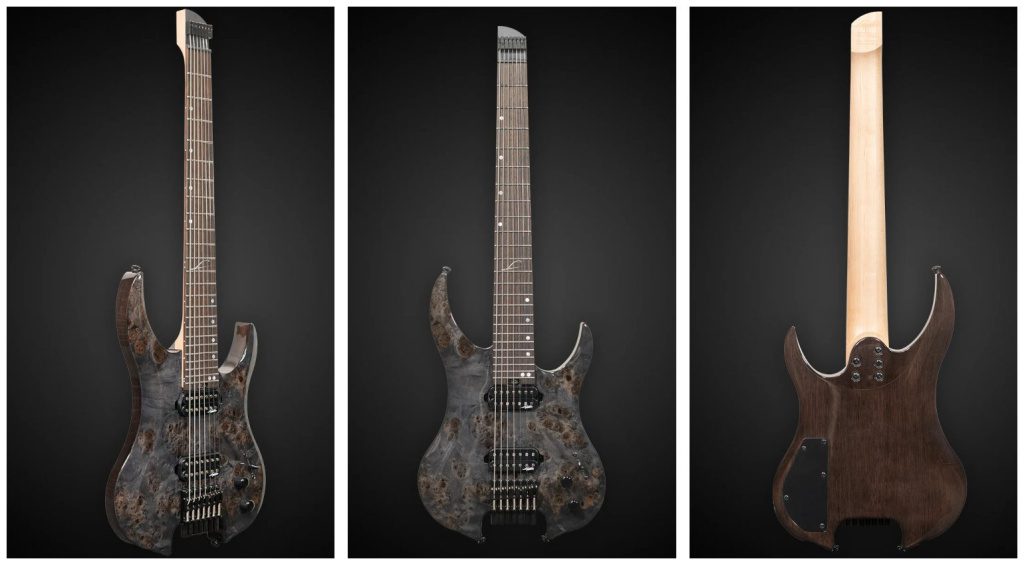
At first glance, headless guitars are characterized by their namesake feature: they lack a headstock. Where the tuners are typically located, we find only gaping emptiness. Instead, the tuners are located either on the body or inside the bridge, which has a decisive influence on both the appearance and the instrument’s functionality.
The technical and ergonomic advantages over traditional models pose several challenges that manufacturers have mastered with innovative solutions.
Functional design
The most striking thing about headless guitars, of course, is the lack of a headstock, which greatly affects its weight distribution. It’s easier on your shoulders and neck without the extra weight at the guitar’s top, which is great for longer sessions. This more balanced weight distribution also results in a more comfortable playing posture, sitting or standing. In addition, neck diving is a thing of the past when you play a headless electric guitar!
The compact design of these headless guitars also facilitates easy access to the higher registers, which can be particularly useful for complex playing styles such as progressive rock or jazz. Despite their compact size, headless electric guitars do not sacrifice sound quality or sustain. Depending on the manufacturer, using more modern materials such as carbon fibers and other composites means that the resonance of these instruments can be maintained. At the same time, they weigh significantly less.
Headless guitars – pros and cons
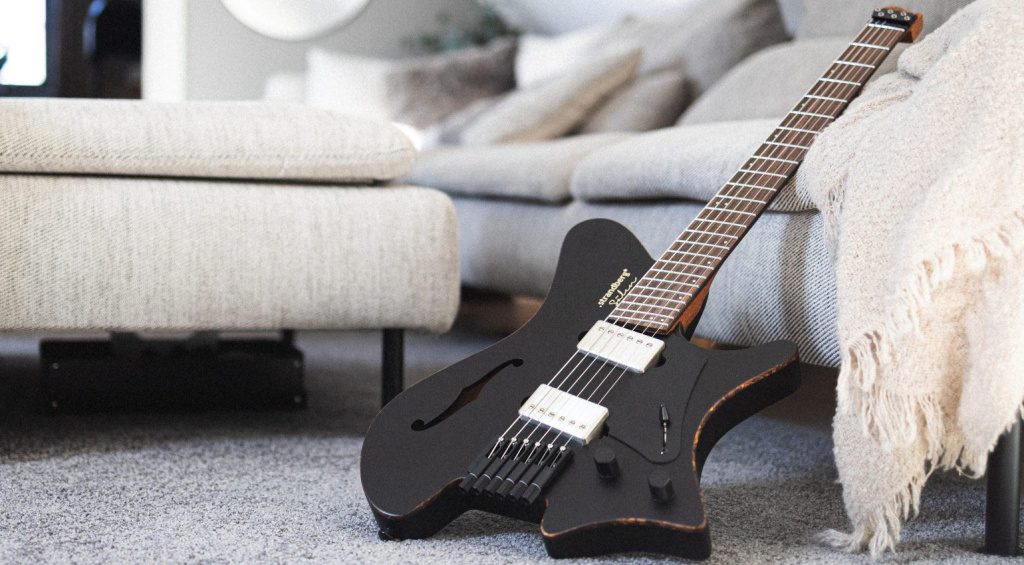
One of the biggest technical challenges in developing headless guitars was the relocation of the tuners. The tuners had to be moved to the guitar’s bridge without a headstock. Many manufacturers have developed fine-tuning systems that precisely adjust the string tension. These systems often offer much better tonal stability than conventional tuners and keep the guitar in tune for a long time, even with intensive use.
Another technical obstacle in developing headless guitars was handling intonation and string tension, especially with multiscale guitars. Using specialized bridges and advanced tuners, such as the Steinberger models, has solved this problem. These tuners allow for quick string changes and precise intonation control, often without specialized tools. Floyd Rose woes? Nope.
An outstanding example of ergonomic innovation is the Strandberg back series‘ EndurNeck profile, which promotes optimal hand posture and significantly reduces the risk of fatigue or injury. This unique neck profile helps guitarists play in a relaxed and comfortable way, even for long periods of time. Admittedly, it costs a lot of money—probably not the best tip as an introduction to the world of headless guitars, but do try it out!
As with any guitar, headless guitars have pros and cons, which should be weighed according to your preferences and playing style.
Pros:
- Lightweight and compact: Headless electric guitars are generally lighter than their traditional counterparts, which can be significantly helpful on tour or during long sessions.
- Improved balance: Without the headstock, the instrument’s weight is more evenly distributed, minimizing top-heaviness and making playing more comfortable. No more neck diving!
- Tuning stability: Thanks to innovative tuning mechanisms, such as those in the Strandberg or Steinberger models, headless electric guitars offer exceptional tuning stability and enable precise fine-tuning.
- Modern look: For many guitarists, the futuristic design is a real highlight that also clearly distinguishes it from classic models.
Cons:
- Unusual look: Traditionalists may need to get used to the absence of a headstock, while some guitarists simply prefer the classic look.
- Spare parts supply: Some headless guitars require special strings or tuners that are not as readily available as standard parts for traditional models.
- Higher price: Especially regarding brands such as Strandberg or Ibanez, which specialize in high-end headless guitars, the costs are often higher than for traditional models.
Besides the price, the advantages and disadvantages for headless guitars are of a more theoretical nature. Choosing either side says more about the guitarist than the guitar itself. I myself am traditionally influenced and will probably never get away from the Les Paul. But that doesn’t mean that I haven’t times where I quite enjoyed jamming on headless guitars.
In the following parts, I’ll introduce you to the six best models currently available. I’m not aiming for a ranking. Each model has a different purpose and a different price. I have also added YouTube videos to each suggestion so you’ll get to hear and see them in action. And of course, you can also find more headless guitars at Thomann!
1. Strandberg Sälen Jazz NX Natural
Looking for the perfect jazz and fusion guitar? The first headless guitar on our list is, admittedly, exotic even among headless guitars. Classic design meets modern technology and ergonomic features.
Its ash body is covered with a maple top, the mahogany neck is reinforced with carbon fibre and topped with a rosewood fingerboard. The two custom Häussel jazz pickups deliver a smooth, nuanced tone that cuts through effortlessly, while the multi-scale frets (stainless steel, of course) ensure excellent intonation and playing accuracy. Thanks to its light weight and excellent balance, the Sälen Jazz NX is ideal for musicians who perform frequently or have long sessions in the studio.
Premium? That’s about as premium as it gets for headless guitars.
Technical details:
- Body: Ash (semi-hollow)
- Top: Maple, with mahogany veneer
- Neck: Roasted maple with EndurNeck profile
- Pickup: Custom Häussel Jazz Pickup Set
- Special features: Multi-scale frets, extremely light, ergonomic design


2. Traveler Guitar Speedster Standard RAT Black
The Traveler Guitar Speedster is a super compact guitar that doesn’t skimp on playability or value for money. It’s probably the most compact 4/4 electric guitar on the market.
The idea behind this guitar was to create something that’s easy to transport, lightweight, and still great for playing. Despite its compact design, it’s got a full-scale length and sounds amazing. The body, neck and fretboard are made of maple, which makes them light but strong. The single, high-output single-coil pickup is loud enough to be audible even in busy environments.
The tuners on this guitar are built right into the body – a clever design that’s simple but effective. The Traveler isn’t meant to be a high-end instrument, but if you use it for what it’s designed for, it’s hard to beat. And you get about 9 of them for the price of a Strandberg.
Technical details:
- Body: Maple
- Neck and fingerboard: maple
- Pickup: High-output single-coil
- Special features: integrated headphone amplifier, extremely compact

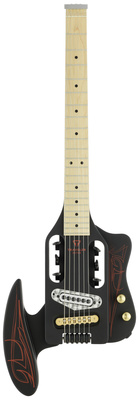
3. Steinberger Spirit GT-Pro Deluxe Black
The Steinberger is also available for well under 500 euros. It’s a classic headless guitar. As a modern update of the Steinberger guitars that gave rise to the headless look in the 1980s, it offers a whole range of sonic options and a still modern, minimalist design.
Its three pickups (HSH setup) and a locking tremolo let you play a range of sounds, perfect for rock, pop or jazz. The electronics are simple, with one master control each for volume and tone. The wood (lime body sides, maple neck throughout) is designed for lightweight construction, and the sound is really malleable. It’s a great all-rounder!
Technical details:
- Body: Maple
- Neck: maple with phenolic fingerboard
- Pickups: 2x humbucker, 1x single coil (HSH configuration)
- Special features: Double-locking tremolo system, ultra-compact


4. Mooer GTRS Wing 900 International APU
If you’re into tech, you’ll love the Mooer GTRS Wing 900 with its integrated tone modelling. The instrument is made from alder and comes with a bolt-on, five-piece neck (curly maple and rosewood), plus a rosewoo fingerboard, and the typical bone nut. And it’s got a classic look. Everything else is pretty cutting-edge.
The integrated GTRS Intelligent Process System which includes a GLB-P1 Li-Ion battery has a variety of on-board guitar tone modelling options: tone modelling, selectable presets, output options, wireless control via app connection, headphone output, 11 instrument simulations, 126 effects and more.
I have to say, this thing is really impressive from a technical point of view. If you’re looking for a one-size-fits-all solution, this is definitely worth a closer look. And if you just want to play guitar, you’ll find a beautifully crafted headless electric guitar with a great sound and excellent playability. Well done!
Technical details:
- Body: alder
- Neck: maple, rosewood (5-piece)
- Pickups: Custom GTRS HM-2N (neck) and Custom GTRS HM-2B Humbucker (bridge)
- Special features: integrated effects, Bluetooth and app control

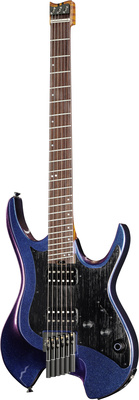
5. Legator Ghost G6SS Black
The Legator Ghost G6SS Black is a modern 6-string headless guitar that’s perfect for guitarists at home in genres such as metal, djent, and progressive rock. Its body is ash, and its two passive Legator Aftershock Ceramic humbuckers (bridge and neck) sound pretty impressive.
Its multi-scale approach gives you a very strong and stable string tension and intonation, especially in low dropped tunings. The body is made from mahogany, its top is finely grained maple. An ebony fingerboard, 24 stainless steel frets and diamond-shaped inlays make it clear that the Legator has a metal-ish feel. And the Legator absolutely delivers.
The excellent ergonomics make it easy to play brutal riffs and cleanly articulated leads, and the design fits like a glove. I highly recommend checking it out. Legator is one of the most exciting ‘new’ names in the headless guitars business to me.
Technical details:
- Body: Mahogany
- Neck: maple with ebony fingerboard
- Pickups: 2 passive Legator Aftershock ceramic humbuckers (bridge and neck)
- Special features: Multi-scale frets (stainless steel), beautiful finish

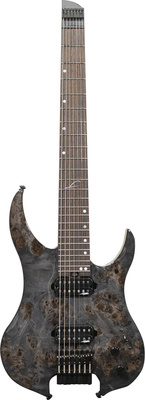
6. Ibanez Q54 BKF
Of course, Ibanez also has a few headless models in its line up. While we are still waiting for a Prestige version, the Japanese guitar giant has ventured into entirely new territory for the first time in a long time with the Q-Series. And iquite successfully at that!
The combination of Nyatoh body, maple bubinga neck and birds-eye maple is drawn from the RG series. The Wizard C-profile feels slick and easy to hold in your hand without being too slim (my issue with most Prestige necks). Specially developed Q58 humbuckers (bridge) and 2 R1 single coils (centre, neck) deliver a balanced, clean sound that offers a whole range of musical palettes.
Weighing in at just over 2 kg, the Q54 is typical of Ibanez in that it is easy to play and, thanks to 24 jumbo stainless steel frets, delivers the complete package that will make both rockers’ and metal heads’ eyes light up.
Technical details:
- Body: Nyatoh
- Neck: Roasted maple, Wizard C-profile, offset mother-of-pearl dots
- Pickups: Q58 humbucker (bridge) and 2 R1 single coils (centre, neck)
- Special features: Gig bag, dyna-MIX9 system with Alter Switch

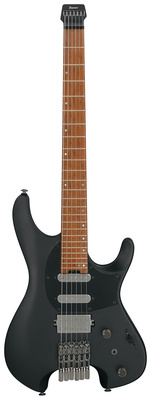
Conclusion: Which headless guitar is for you?
There are now more headless electric guitars on the market than ever before, and they’re more affordable than ever, too! Whether you’re an experienced guitarist who travels a lot and you’re looking for a compact, reliable guitar. Or you’re a metal player who needs an ergonomic guitar with precise intonation and strong tuning stability. There’s a model to suit your needs!
*This post contains affiliate links and/or widgets. When you buy a product via our affiliate partner, we receive a small commission that helps support what we do. Don’t worry, you pay the same price. Thanks for your support!
One response to “The Six Best Headless Guitars: Headless to Happiness”

 3,4 / 5,0 |
3,4 / 5,0 | 




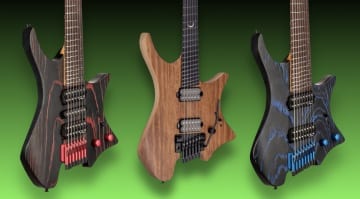
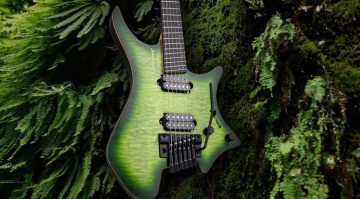
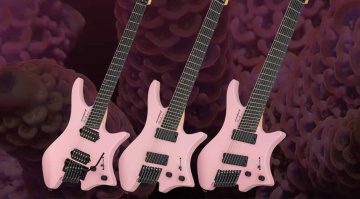


What about Kiesel, they make several headless models. Yes, they’re online only, but have many in-stock guitars